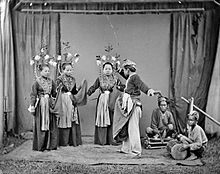
Sulawesi, also known as Celebes, is an island in Indonesia. One of the four Greater Sunda Islands, and the world's 11th-largest island, it is situated east of Borneo, west of the Maluku Islands, and south of Mindanao and the Sulu Archipelago. Within Indonesia, only Sumatra, Borneo, and Papua are larger in territory, and only Java and Sumatra are more populous.
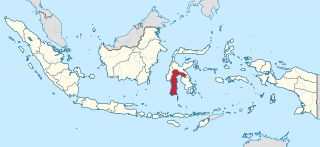
South Sulawesi is a province in the southern peninsula of Sulawesi, Indonesia. The Selayar Islands archipelago to the south of Sulawesi is also part of the province. The capital and largest city is Makassar. The province is bordered by Central Sulawesi and West Sulawesi to the north, the Gulf of Bone and Southeast Sulawesi to the east, Makassar Strait to the west, and Flores Sea to the south.

Kecak, alternate spellings: kechak and ketjak), known in Indonesian as tari kecak, is a form of Balinese Hindu dance and music drama that was developed in the 1930s. Since its creation, it has been performed primarily by men, with the first women's kecak group having started in 2006. The dance is based on the story of the Ramayana and is traditionally performed in temples and villages across Bali, Indonesia.
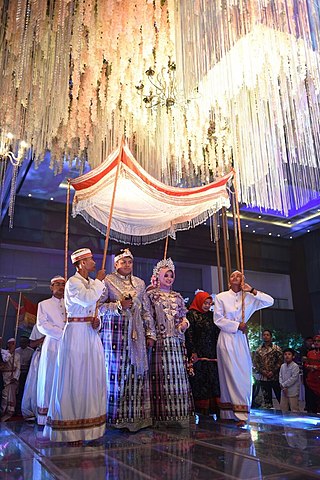
The Bugis people, also known as Buginese, are an Austronesian ethnic group—the most numerous of the three major linguistic and ethnic groups of South Sulawesi, in the south-western province of Sulawesi, third-largest island of Indonesia. The Bugis in 1605 converted to Islam from Animism. Although the majority of Bugis are Muslim, a small minority adhere to Christianity as well as a pre-Islamic indigenous belief called Tolotang.

The Torajans are an ethnic group indigenous to a mountainous region of South Sulawesi, Indonesia. Their population is approximately 1,100,000, of whom 450,000 live in the regency of Tana Toraja. Most of the population is Christian, and others are Muslim or have local animist beliefs known as aluk. The Indonesian government has recognised this animistic belief as Aluk To Dolo.
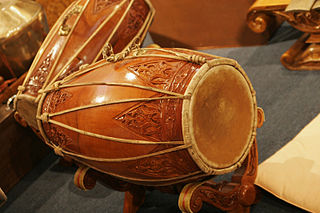
A kendang or gendang is a two-headed drum used by people from the Indonesian Archipelago. The kendang is one of the primary instruments used in the gamelan ensembles of Javanese, Sundanese, and Balinese music. It is also used in various Kulintang ensembles in Indonesia, Brunei, Malaysia, Singapore, and the Philippines. It is constructed in a variety of ways by different ethnic groups. It is related to the Indian double-headed mridangam drum.
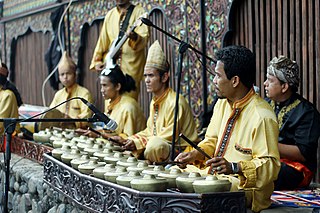
Talempong is a traditional music of the Minangkabau people of Western Sumatra, Indonesia. The talempong produce a static texture consisting of interlocking rhythms.
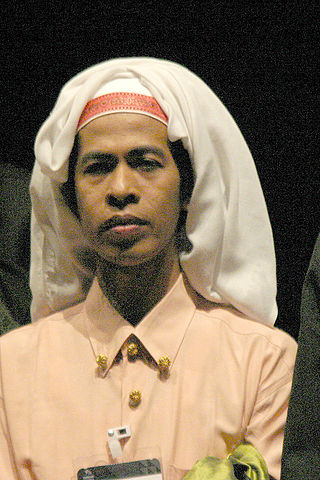
The Bugis people are the most numerous of the three major ethnic groups of South Sulawesi, Indonesia, with about 3 million people. Most Bugis are Muslim, but many pre-Islamic rites continue to be honoured in their culture, including the view that gender exists on a spectrum. Most Bugis converted from Animism to Islam in the early 17th century; small numbers of Bugis have converted to Christianity, but the influence of Islam is still very prominent in their society.
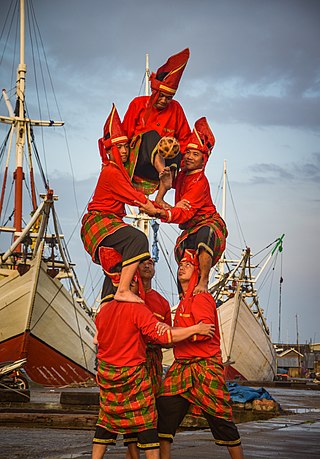
Sepak raga is a traditional Indonesian and Malaysian sport, developed in the Nusantara Archipelago. This game is related to the modern sepak takraw. Similar games include footbag net, footvolley, bossaball and jianzi.

Gandrung is a traditional dance from Indonesia. Gandrung has many variations and is popular in Bali, Lombok, and Eastern Java among the Balinese, Sasak, and Javanese. The most popular variation is gandrung from the Banyuwangi region in the eastern peninsula of Java; thus, the city is often referred to as Kota Gandrung, or "the city of gandrung". Originally a ritual dance dedicated to the goddess of rice and fertility, Dewi Sri, it is currently performed as a social dance of courtship and love in communal and social events, or as a tourist attraction. Gandrung Sewu Festival is held at Banyuwangi annually.

Piring dance is a traditional Minangkabau plate dance originated and performed in West Sumatra, Indonesia. It is also performed in Negeri Sembilan, Malaysia. The dance might be performed by a group of women, men, or couples; each of whom holds a plate in each hand, and vigorously rotates or half rotates them in various formations and fast movements.
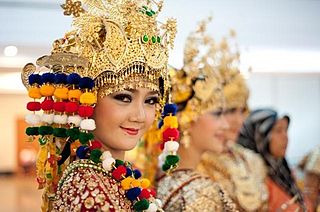
Gending Sriwijaya is the name of the traditional performance whether it is a song, music, as well as dance that originated from Palembang, South Sumatra, Indonesia. Both of the song and the dance was created to describes the splendor, cultural refinement, glory and the grandeur of Srivijaya empire that once succeed on unifying the western parts of Indonesian archipelago and Malay world generally.

Singo Ulung is one of the original traditional dances from Bondowoso regency, East Java, Indonesia. The dance is played by two people in a lion-like costume and accompanied by music.
Bajidor Kahot is a Sundanese dance from Indonesia which combines the dance movements of Ketuk Tilu and Jaipongan as the basis of its motions. What distinguishes them from the two, Bajidor Kahot dance does not optimize shoulder movement as the Jaipongan and Tap Tilu do. In the dance, hips, arms, shoulders, head, and hands move dynamically. Footsteps also incorporated into the dance. The dancers wear typical Sundanese kebaya. The kebaya is designed fit the shape of the body and the clothes are brightly colored. Additional accessories such as scarves and fan are incorporated into the dance. Often the dancers are also moving in formation of interest. Bajidor Kahot dance was created c. 2000. In each show, dance is always accompanied by a typical drum from the land of Pasundan. In addition, the Balinese gamelan music adds to the wealth of music that accompanies the dance. As in Jaipongan, Bajidor Kahot is often performed by young women. The dance usually performed by four to eight dancers.

The bodo blouse, locally known as baju bodo, is a sheer and transparent short-sleeved loose blouse, a traditional attire for women of the Bugis and Makassar peoples of South Sulawesi, Indonesia. A bodo blouse is traditionally combined with a matching woven sarong that covered the waist below the body.

In Indonesia, a fire performance is a group of performance arts or skills that involve the manipulation of fire. It includes using fire as a finale in an otherwise non-fire performance. Performances can be done as choreographed routines to music.
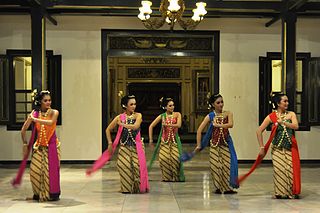
Gambyong is a traditional Javanese dance originating from Surakarta, Central Java, Indonesia. It has existed since ancient times, and began to be displayed at the Mangkunegaran Palace in the era of 1916 to 1944. Gambyong became famous for its smooth and graceful dance moves that amazed the audience who watch them.
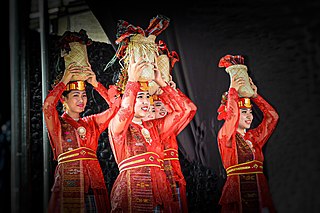
Tandok dance is a traditional Batak dance originating from the North Sumatra, Indonesia. This dance tells about the activities of harvesting rice using tandok carried out by mothers in the fields. In addition, this dance also contains the importance of family values between each other.
Banjar Mask Dance is a local indigenous art form of Banjar in South Kalimantan, Indonesia. It is called mask dance because the dancers use masks (Topeng) when dancing. This dance is usually played for sacred ceremonies, such as the manyanggar ceremony. The ceremony is a ritual to clean inherited equipment, treat supernatural diseases, give thanks after harvesting, cleansing the village of evil spirits, and ask for protection from disasters. The Banjar mask dance will be performed in the form of a wayang wong, where the dancers will wear masks and are accompanied by a set of gamelan salendro.
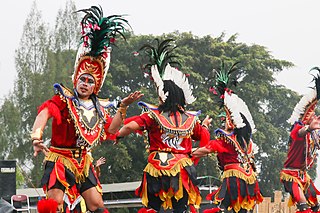
Ireng mask dance also known as Topeng Ireng or Dayakan is a traditional Javanese art that developed in Magelang Regency, Central Java, Indonesia.



